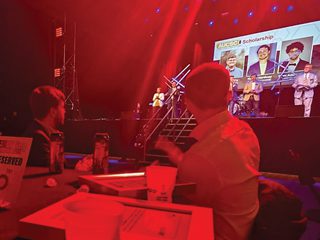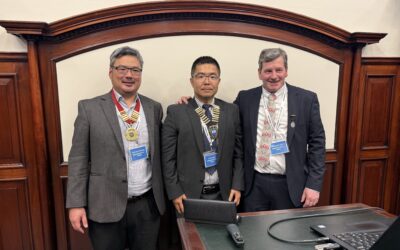The Fifth of the Series of YEP AMPP Journals, by Praveena Nanthakumaran, Now a Project Engineer at Alfanar.
AMPP Diary
As a previous Mechanical Engineering Graduate at Worley, I participated in ICorr’s Young Engineers Programme (YEP) 2020, which was sponsored by bp. The YEP 2020 case study was on the failure of titanium piping in an onshore desalination glycol plant, and I was part of the winning team. I celebrated alongside ICorr’s YEP 2022 winners at AMPP’s (Association for Materials Protection and Performance) 2023 Conference and EXPO in Denver, Colorado.
YEP 2020
ICorr’s year-long programme was targeted at young engineers with an interest in the Corrosion industry.
The programme consisted of a series of monthly evening lectures presented by corrosion subject matter experts. Midway through the year, the cohort was divided into teams to work on a real-life case study.
Before the covid pandemic, we had the opportunity to network with like-minded-engineers and researchers in the programme, and also connect with the more senior engineers and mentors. However, in 2020, covid-19 hit, and we moved to virtual sessions. We had to adapt to 100% remote learning and presenting in March 2020. Although these changes were initially perceived as challenges, they soon became the norm. The lectures covered a variety of topics, including but not limited to: Principles of corrosion, Fire protection, Corrosion under insulation, Welding and Non-Destructive Testing (NDT), Cathodic protection, Integrity management, and Fitness for service.
Our case study was on the failure of Titanium piping in an onshore desalination glycol plant. I was part of a team that included four other types of engineers: a welding specialist, two corrosion engineers, and a civil engineer). Our team mentor was Tasos Kostrivas (McDermott International).
Equipped with the knowledge from our lectures, a dedicated mentor, diverse strengths within the team, and our own eagerness for independent study, we began working on our case study. We were
given a process diagram, background information about the facility, activities taking place within it, leakage photographs and where they occurred in the facility process. Outside of our monthly evening
lectures, our group met virtually over MS Teams to piece together the information and find the cause of the failures as well as solutions to this real-life problem.
Summarising Our Findings
The primary material of construction in the plant was Titanium Grade 12. The plant saw in Mono Ethylene Glycol (MEG) that was returning onshore with containments, most of which were salts. These salts were removed within the facility via vacuum distillation and recycled. It was possible that under normal operations within the plant, there were organic acids present. Our overall findings were that initial plant environmental factors lead to the degradation of the incoming MEG.
Contributing environmental conditions were:
- Oxygen ingress via a plant equipment in the process,
- High temperatures of the process, and
- Presence of chlorides.
MEG degradation resulted in a mixture of acids (oxalic acid, acetic acid, and formic acid). Within the plant process, these organic acids lowered the pH. The presence of deposited metals and low pH led to metal dissolution and embrittlement.
We concluded that brittle fracture occurred due to:
- Hydrogen absorption,
- The sensitive location at the weld, and
-
The Ti microstructure that was susceptible to cracking. Our Ti microstructure had beta phases, which are known as easy paths for hydrogen transport because they have a relatively loosely packed structure and thus high diffusivity and solubility of hydrogen compared to the alpha phases of Ti Grade 12.
After identifying the mechanisms of corrosion, our team developed a risk assessment that evaluated the hazards, the consequences, and probability of each hazard item. We assigned each item a risk level and assessed whether the risks were acceptable. We then developed mitigating options via the principles of Eliminate Reduce Isolate Control (ERIC). Our final mitigation methods were to minimise oxygen ingress, carry out effective inspections, plan emergency repairs, and implement a robust long-term plan. For emergency repairs, alternative material options such as carbon steel were considered. For long-term plans, Ti was still the preferred material. Ti Grade 7 or Grade 11 were better options than Ti Grade 12 because they are pure alpha grades, have excellent weldability and fabricability, strength, and are the most corrosion-resistant Ti alloys.
AMPP 2023
I joined the winners of YEP 2022 at this year’s AMPP 2023 conference and EXPO, which has been the best experience of my engineering career to date. I was extremely grateful for this opportunity. The enormous size of the organisation and the breath of topics covered by AMPP were a reminder of the importance of the event. It was a very well-organised event. I enjoyed the week of Continuous Professional Development (CPD) and networking. Some of the highlights of AMPP for me included the inspector workstations, speaking with students at the poster competition, learning about hydrogen sulphide (H2S), enrolling in the AMPP leadership programme, and, of course, the awards ceremony!
Coatings Inspection Instruments Workshop
This workshop was designed for members who wanted to learn about the basics of instruments and pursue an AMPP Coating Inspector Certification, which has three certification levels, starting with CIP Level 1 as a Basic Coatings Inspector and ending with CIP Level 3 as a Senior Certified Coatings Inspector. The workshop was delivered by Bill Corbett and Lake Barrett from KTA-Tator Inc. They introduced us to various measuring tools, gauges, and visual SSPC Surface Cleanliness Standards (VIS 1 and 3) and how to use them in coating inspection on the shop floor or out in the field. The drop-in workshop had workstations where participants could use the various coating inspection tools or guides to assess samples, such as assessing the quality of abrasive blast blowing and the use of depth micrometres vs. replica tapes. It was a great hands-on session, and even though I am not a Coating Inspector expert, the stations gave me an appreciation for the work that our fellow Coating Inspectors do, the tools that they use to assess equipment, and what they are looking out for when called out.
H2S, H2S Management and the Benefits of Acrolein Over Other H2S Scavengers
Through a series of lectures, I learned about H2S,H2S management,
the benefits of acrolein over triazines, and THPs in controlling H2S.
H2S
H2S is a highly corrosive colourless gas that presents problems associated with personal safety, increased corrosion damage (e.g.,
in pipelines, which can experience hydrogen sulphide stress cracking, hydrogen embrittlement, and pitting corrosion), emissions to the environment, and exposure to people. There are also threshold limits in place on the amount of H2S that a hydrocarbon product can contain before it is sold. If they are off-spec, there can be large OPEX costs. To manage all these different issues, H2S management needs to be in place.
Importance of H2S Management
H2S management in the Oil and Gas (O&G) industry refers to the strategies, practices, and technologies used to monitor, control, and minimise the presence and effects of H2S in hydrocarbon streams.
| Issues |
Impacting |
| Environmental and Safety – H2S emission / exposure |
OPEX, Liability |
| Fines for off-spec oil and gas |
OPEX |
| Gas sweetening
equipment, towers |
CAPEX |
| Metallurgical upgrade
for sour services |
CAPEX |
| Under deposit and localised corrosion, plugged due
to iron sulphide
|
Integrity management,
flow assurance |
| Disposal of spent tower sweetening chemicals |
OPEX |
| Leadership |
Employees |
| Monitor H2S levels
throughout the facility and address any issues |
Pay attention for signs of H2S |
| Establish a process for responding to an H2S
exposure event |
Notify management of any unusual smells or issues with workplace ventilations |
| Provide H2S
training and PPE |
Compete H2S training
and wear the provided PPE |
| Identity hazards that could
lead to an acclimation of H2S |
Follow safety procedures
at all times |
Both workers and leaders have a responsibility to prevent H2S-related incidents wherever possible. Below are just some actions I learned we can take:
Benefits of Acrolein Over Other H2S Scavengers
A Hydrogen Sulphide (H2S) scavenger is a specialised chemical or fuel additive widely used in hydrocarbon and chemical processing facilities. These injected chemicals react selectively with and remove H2S to help meet product and process specifications.
Products treated for H2S include crude oil, fuels, and other refined petroleum products in storage tanks, tanker ships, rail-cars and pipelines.
Triazines and Tetrahydrothiophenes (THPs) are broadly applied as a scavengers in the O&G industry. They have been used for many years and are still very popular. Triazine-based scavengers are a very common chemical and are deemed to be low cost. However, some of their disadvantages are that there are issues with its effectiveness when H2S concentrations are low. They also have low efficiency in water treatment as the Triazines shift the pH of water, causing scaling issues. As a result, Triazine products are often treated with scale inhibitors beforehand to help minimize these scaling issues. THP-based products involve irreversible reactions and require a fairly high treatment dosage, with the minimum effective dosage being 2000 parts per million (ppm). In contrast we learnt that Acrolein does not need very high doses to treat. Acrolein can achieve the same performance as THPs with just 150pp. This is a drastic dosage requirement difference compared to 2000ppm and can be a huge cost saving.
Despite its benefits, Acrolein is not as popular as its aforementioned counterparts in the O&G industry as the market is not comfortable using it due to its high reactivity, hazardous nature, and its requirements for a closed delivery system. A closed delivery system is one in which there are safety and control measures in place to ensure there is no spillage that may cause harm to the environment or personnel. Acrolein has a very unique chemistry, with its two carbon-carbon double bonds situated very close to each other, making it highly reactive with Sulphide ions in water as well as other different in situ liquids/gases. While Acrolein is a hazardous chemical, special safety handling mechanisms are normally in place (such as handling on site and transporting in the supply chain to ensure there is no spillage) to make it safe. Additionally, its reaction by-products are very user friendly and non-hazardous. Acrolein is mostly used we learnt in vessel clean-outs (e.g. water tanks and slop tanks), downhole treatments and surface treatment of frac. ponds.
Other features that we were made aware of include but aren’t limited to:
- Oil and water soluble to some degree,
- Water and oil soluble byproduct, and
- Minimal environmental persistence.
Overall, Acrolein provides an effective alternative to Triazines and THPs as a H2S scavenger, with the potential for lower dosage requirements and more user-friendly reaction by- products. However, its hazardous nature and unique chemistry require special safety measures to be in place to prevent harm to the environment or personnel.
AMPP Student Poster Completion
I was in awe of the young talent that was present at the conference. On the first day of the EXPO opening was the poster competition, where young graduates and PhD students were presenting their months (or years) of hard work and research to the wider AMPP community. There was also a panel of judges making their rounds. It was fantastic to learn directly from enthusiastic young students. Our discussions made me reconsider pursuing another degree! The students were able to condense their months and years of hard work into an easy-to-understand whistle-stop tour of research concept stages through to their findings and further work. I especially enjoyed Menna’s studies on the use of degradable materials and Yuki’s research on End of Life’ Al alloys.
Poster Presentations
Menna Walid was exploring the use of special coatings on degradable implants. Our bodies may need to undergo surgery for internal bone implants when our bone fractures are too complex to fix externally. Menna researched the use of fluoride plasma electrolytic oxidation (PEO) as a coating for MgCa.
There are two roads we can go down for bone implants:
- i) Typical permanent metallic implants, or
- ii) biodegradable options.
Current permanent metallic implants pose two great challenges: 1) stress shielding and 2) surgical interventions. Stress shielding occurs because the permanent metallic implants are very stiff (100-200 GPa) compared to the adjacent cancellous bones (10-30 GPa). The difference in stiffness causes early implant loosening, skeleton thinning, and chronic inflammation. The second issue with permanent metallic implants is the need for surgical intervention. Metallic implants need to be removed 1-2 years after the first surgery, which comes with additional personal, medical, and social costs. With a biodegradable implant option, we can remove the need for a surgical intervention and reduce stress-shielding challenges.
Yuki Ando’s explored End of Life (EOL) content in Aluminium (Al) alloy parts to fabricate new Al alloys. In Yuki research, he assessed EOL contents of 0%, 40%, 75%, and 90% for Aural2 (e.g., EOL 40 means 40% EOL material and 60% primary material). In this context, secondary alloy means that the Al alloy contains a secondary resource as a component. Cast Al alloys are widely used in automotive applications because of their strength-to-weight ratio and their ability to promote sustainability. The industry uses about 35–40% of EOL-based Al. However, each time we recycle Al, we can expect impurities such as calcium (Ca), zinc (Zn) and copper (Cu) to be introduced.
Annual Scholarship Awards and EMERGing
Leaders Bash
On the 21st March, we took coaches to the Fillmore Auditorium for AMPP’s annual Scholarship Awards and EMERGing Leaders Bash. Fillmore Auditorium is where the great legend Jimi Hendrix performed! Other notable legendary artists who have performed here include Oasis, Blink 182, Ozzy Osbourne, and Cyndi Lauper.
The event kicked off with a bp welcome social, which was then followed by the evening ceremony of recognition and then dancing and singing along to Groove Merchants Band. Award recipients were selected based on their academics and commitment to the corrosion industry. It was great to be able to celebrate amongst the other YEP winners and our AMPP leadership cohort friends. I also recognised several other emerging students from the presentation evening. It was a wonderful night and a great way to let our hair down and jam to the Groove Merchants Band. It was then followed by an after-party at Charlie’s!

AMPP Leadership Programme
I am most grateful to have secured a place on this year’s EMERG AMPP leadership programme alongside 13 others. Our cohort was composed of engineers, managers, and researchers with diverse backgrounds, experiences, and perspectives, which made our group unique and dynamic as a leadership team. Our first in-person session in Denver gave me an appreciation for the breadth of perspectives across different industries and the similarities in the group’s challenges as leaders.
I especially enjoyed the emotional intelligence workshop delivered by Phil Reynolds. Phil’s session let me reflect on my previous role as Safety and Assurance Package Manager at Atkins on a large nuclear and defence project. For example, I learned how to capitalise on my current strengths and bolster my relationship management skills to foster a culture of collaboration and respect.
Since the conference, we have had two further sessions and started on our group project, “How we can build upon AMPP’s diversity.”
I am excited about strategising with my team and making a lasting impact on AMPP.

Conclusion
If you are just starting your career as a young engineer and are interested in corrosion, I highly recommend applying for the ICorr’s YEP. It was an eye-opening experience. I have learned from SMEs in the industry, made fantastic friends along the way, and gained new and exciting opportunities through the programme.
Additionally, the annual AMPP conference is incredibly valuable for knowledge transfer, networking, and potentially finding new clients or services for your company.
Congratulations again to all award recipients and presenters! Thanks once again to all involved in helping me succeed along the way. Here’s to more in 2024!
CAPTIONS:
ICorr Table at AMPP-EMERG prize winners event.
YEP 2022 Winning Team With Praveena Nanthakuma, (Centred with ICorr President).



